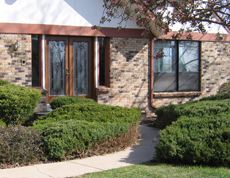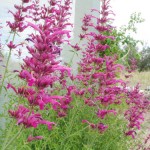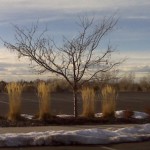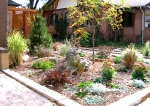by Matt Corrion
Juniper bushes are the most despised landscaping plant in existence. I know this to be true, because 75% of the time that I talk with a homeowner or property owner about renovating their landscape, they say something like “those Junipers have GOT to go!”.

Juniper bushes are common in older landscapes. Here they were not given adequate room, so they have been sheared off along the walkway.
Why is this? I think there are a few main reasons, aside from the fact that they are prickly beasts that we have all tangled with a one point (either landing in one while playing as a kid, or getting that annoying rash on your arm while trimming them) :
1) They were simply overused in the past. People are just tired of them and want something unique and new. And since they live for ages and rarely die, they are often the only living survivors guarding the front doors of homes in any older neighborhood.
2) They were not planted with enough room to grow. Many of the varieties get quite large after say, 20 years, and quickly outgrow the planting bed. Because they grow too large for their setting they require excessive pruning to keep them at a manageable size. This pruning then exposes all of the dead old growth inside the base of the plant- ugly!
3) The aforementioned prickliness. And good luck getting the baseball you were tossing around out of the center of that green monster.
Given these negatives, why then should you consider using Juniper plants in your landscape?
(more…)
Related Posts:
by Matt Corrion
Converting an outdated landscape into landscaping that uses less water is not as hard as you might think. And there are many benefits!
One of the best ways to do this is to convert your high water-use landscaping into a Xeriscape (pronounced “zeer-escape”). This can be done anywhere- from a small home landscape, to a large commercial property.
Many people have an image of Xeriscape as a “sea of rocks, with a few cactus plants”. But Xeriscape can also be a lush, green and colorful landscape that is interwoven with flowering plants, textures, and beauty throughout each season. In my opinion it is much more beautiful and interesting than “traditional” landscaping.
The Top 10 Benefits Are:
10. Less Maintenance
9. Use Less Water & Better for the Environment
8. Prevent Water Damage
7. More Beautiful, Colorful & Unique
6. Better Wildlife Habitat
5. Less Fertilizers & Pesticides Needed
4. Better Suited to Your Site’s Unique Conditions
3. More Winter Beauty
2. Better Prepared for Drought
1. Saves You Money
Now I will discuss each benefit in greater detail and explain what each one can mean for you:
(more…)
Related Posts:
by Matt Corrion
I often get asked to recommend Xeriscape plants for Colorado landscapes. This is a difficult task because there are so many to chose from, and I would hate to limit anyone’s pallette to a limited number. After all, it is the variety in color, textures, and form that makes Xeriscaping so attractive.
That being said, I do think a small list can be helpful to people who are new to the area, or are not familiar with the available plant choices and may be overwhelmed by a catalog of thousands of plants. Although this is a Colorado list, most of these plants can be used in many places throughout the world depending on the local climate.
- Fernbush – Chamaebatiaria millefolium Fernbush is a medium sized shrub with interesting fern-like leaves that persist throughout the winter. This shrub requires little water or maintenance, and produces clusters of small white flowers in the late spring through early summer.

- Agastache – Agastache ssp. Agastache, or hummingbird mint, is a fragrant group of colorful perennial herbs that is available in many colors mostly ranging from orange to pink. The plants are covered with beautiful tubular flowers from mid-summer to fall. Hummingbirds absolutely love these plants. (more…)
Related Posts:
by Matt Corrion

Brrrrr… It’s cold out there! The last thing you are probably thinking about is landscaping. Or, if you are like me you already have the itch to get outdoors and are counting the days until spring. Whether you are a restless home gardener looking for reasons to get outside, or you are performing maintenance on a commercial property and want to do all you can to have it look great some spring, there are many tasks that can be accomplished over winter. Get the hot chocolate ready!
Key Dates
- Late February: Stop any pruning from this point on- spring is right around the corner, and woody plants are developing buds and preparing for the new season.
- Late March: Plants will begin to emerge for spring at this time. As plants (especially Xeriscape plants) emerge and show signs of new growth, begin to remove any heavy mulching that was done to protect them over the winter.
Trees and Shrubs
- Apply tree wrap to the trunks of young trees, early in the winter. This protects the bark from sun-scalding and damage from harsh winter winds.
- Watch for any heavy, wet snowfall. This can break off branches of trees and do a lot of damage. Shake heavy snow from trees and shrubs that are bending and showing stress. While this can be a threat throughout winter, trees are particularly vulnerable in early spring when buds and leaves are beginning to emerge, because this creates more surface for the wet snow to stick to.
- Hand-water your trees and shrubs if dry periods persist for a month or longer and the ground is not frozen. Keep in mind that areas facing the south and west will need water more than areas with northern exposure where snow will stay on the ground longer. Water in the middle of afternoon when temperatures are warmer (above 40 degrees Fahrenheit). You only do this about one time per month, and only if dry conditions persist.
- Make sure you have plenty of mulch around trees and shrubs- this helps maintain moisture and keeps the soil from drying out over the winter.
- Finish any pruning of trees and shrubs in January. When pruning trees, look to remove branches that appear likely to grow into each other or rub against other branches. When pruning shrubs, always try to maintain the natural size and growth habit of the species. Always use the right tool for the right cut.
Perennials and Ornamental Grasses
- Leave spent stems and seed heads on grasses and perennials until spring, to enjoy their winter beauty and to provide cover for birds and wildlife. If ornamental grasses and perennials have “flopped over” due to repeated snowfall, go ahead and cut them back now to achieve a neater look- otherwise, wait until early spring.
- Late in March begin to remove any heavy mulching that was done in the fall/winter to protect the plants and preserve moisture. We usually receive plenty of precipitation in March and April in the form of wet snow and rainfall. If there is too much mulch around the base of perennials and ornamental grasses (especially Xeriscape plants with low water-use requirements) then stem rot and root rot can occur if the mulch is too thick in the spring.
Lawns
- Minimizing traffic on lawns will help to keep from damaging the grass, especially if it has been a dry winter or the ground is frozen.
Winter Weather Considerations
- January and February are the driest months of the year (in terms of precipitation) for the Front Range of Colorado. Watch soil moisture closely, and hand water your plants if you receive little snowfall. In March, the level of precipitation generally picks up quite a bit.
Other
- If you are feeding birds, try to keep your feeders full as birds can become dependant on this source of food in winter.
- If it has been a dry winter, when you are plowing or shovelling snow strategically place snow around the base of trees and shrubs to provide added moisture.
- Start planning for design changes to your landscape for summer. Now is a good time to get your plans in order, and spring is the best time to establish new plants- so get ready early, because it will be here before you know it!
- Finally, sit back and wait for SPRING! A cozy fire and a warm drink will make the wait more bearable.
This is the official blog of Outdoor Design Group, Colorado Landscape Architects. For more information about our business and our services, click here.
Related Posts:
by Matt Corrion
 Fall. When the morning air turns crisp and cool and the leaves begin to float softly to the ground. Not only is it my favorite season, there are many maintenance tasks to be accomplished in the landscape. The info below includes tips on what I have found are the most important and useful tasks- so get out there, have fun with it, and enjoy the autumn weather!
Fall. When the morning air turns crisp and cool and the leaves begin to float softly to the ground. Not only is it my favorite season, there are many maintenance tasks to be accomplished in the landscape. The info below includes tips on what I have found are the most important and useful tasks- so get out there, have fun with it, and enjoy the autumn weather!
Key Dates
- Early October: It is a good idea to winterize your irrigation system and blow out the lines. Many landscape maintenance companies will provide this service for less than $50, or it is pretty simple to do it yourself.
- October 15th: Don’t plant any grasses or perennials after this date. Many of them won’t survive, and you will have much better luck in the spring.
- November 1st: Don’t plant any evergreens (especially trees) after this date. Some deciduous trees and large deciduous shrubs can be planted later if they are balled and burlapped (B&B), but I would recommend waiting until spring when you’ll have much better success.
Trees and Shrubs
- Prune trees and shrubs to remove dead branches or to control their size. Fall is the best time to do this for the health of the plants. Consider consulting with an arborist before any major pruning on trees, or at least do a little research on techniques. When pruning shrubs, always try to maintain the natural size and growth habit of the species- Avoid over-pruning or sculpting unnatural shapes, unless you are creating a specific look such as a hedge. Instead of using power shears to lap off shrubs on a straight line, consider using hand pruners to thin the interior branches to maintain a healthier more natural look.
- Remember to check soil moisture, and water if needed. Even though you may have your irrigation system shut down for the year, fall often brings some warm, windy days that can really dry things out. Pay special attention to anything that was just planted this year.
- Make sure you have plenty of mulch around trees and shrubs- this helps maintain moisture and keeps the soil from drying out over the winter.
Perennials and Ornamental Grasses
- Prepare tender and semi-hardy perennials and shrubs for the upcoming cold winter. I like to let a few of the fallen leaves that tend to build up around the bases of these plants remain there for the winter- they will provide insulation around the base of the plant from the cold. This also saves you some leaf cleanup now that you can do in the early spring. If necessary, place additional wood mulch around the base of these plants for more insulation- pay particular attention to areas with northern exposure.
- Leave spent stems and seed heads on grasses and perennials until spring, to enjoy their winter beauty and to provide cover for birds and wildlife. Or, if you must have a neater look you can cut them back now, to a height of about 6-8″ off of the ground.
- Dividing: Some plants can be divided in the fall and replanted in other areas. Other species don’t like the fall division/planting though, and I think that spring is a much better time to do it. If you decide to divide, remember to water the plants well for a couple of weeks.
Lawns
- Rake those leaves! If left on the lawn they can smother it and cause issues such as mold and fungus.
- Consider aerating your lawn. Aeration allows greater movement of water, fertilizer, and air which stimulates healthy turf. Aerating also increases the speed of decomposition of the grass clippings and enhances deep root growth. Compacted soil especially benefits from core aerating.
- You may want to fertilize your lawn or use a “weed and feed” type light pre-emergent herbicide in the fall for maximum growth the following spring. Don’t over do it though, because fertilizer and herbicide can wash off of your lawn and the runoff can be harmful to water supplies and wildlife.
- Assess the size and configuration of your lawn, and how much water you used this year to keep it green (or, brown?). Consult with a landscape architect about how you can redesign your landscape to make it more attractive, sustainable, and functional.
Fall Weather Considerations
- The days are getting shorter and the weather is getting cooler. Keep an eye on the amount of precipitation we are getting- Fall can have extremes of hot and cold, dry and wet. Be observant. If you have heavy rain for a couple of days then turn off the sprinklers for a week or so to compensate. And if you have several days of warm, sunny weather then your landscape will certainly appreciate an extra drink.
Other
- Disconnect and drain hoses, but keep a hose handy for winter watering. I also like to wrap insulation or put insulated covers over the exterior faucets as an added protection from freeze damage (I once had a pipe freeze and break UNDER my porch, and had to take apart the porch to fix it!).
- Collecting seed: Stop deadheading late in the year and allow the seedheads to dry on the plant. Then you can collect the dried seeds to plant next spring. Store them in a cool, dark place in a container that does NOT have an airtight seal, such as an envelope (it’s also a good idea to label the container so you remember what plant it is next spring). Another option- leave the seeds on the plants and some perennials will re-seed themselves naturally.
- Start planning your spring bulb garden now. Spring-blooming bulbs are planted in the fall to provide the chilling time required for spring blooms. Remember to prepare the soil and plant bulbs at the appropriate depth listed on the package for the species.
- Start planning for design changes to your landscape for next year. Fall and winter are the best times to get your plans in order, and spring is the best time to install the changes- so get ready early for next spring, because it will be here before you know it!
- Take a break and toss the football around. Afterward, enjoy some warm apple cider with cinnamon. Finally, rake your leaves into a giant pile and take turns jumping into them with the neighbor kids!
This is the official blog of Outdoor Design Group, Colorado Landscape Architects. For more information about our business and our services, click here.
Related Posts:



 Fall. When the morning air turns crisp and cool and the leaves begin to float softly to the ground. Not only is it my favorite season, there are many maintenance tasks to be accomplished in the landscape. The info below includes tips on what I have found are the most important and useful tasks- so get out there, have fun with it, and enjoy the autumn weather!
Fall. When the morning air turns crisp and cool and the leaves begin to float softly to the ground. Not only is it my favorite season, there are many maintenance tasks to be accomplished in the landscape. The info below includes tips on what I have found are the most important and useful tasks- so get out there, have fun with it, and enjoy the autumn weather!